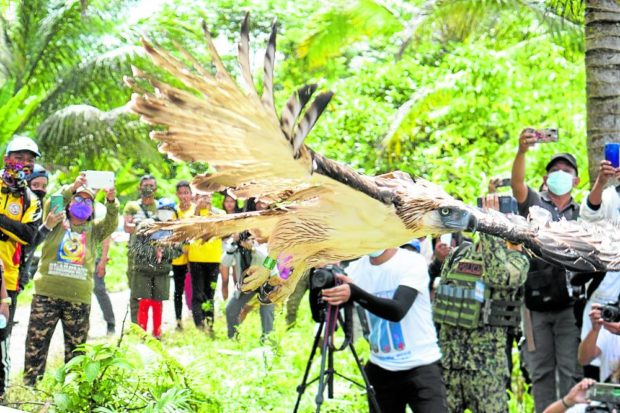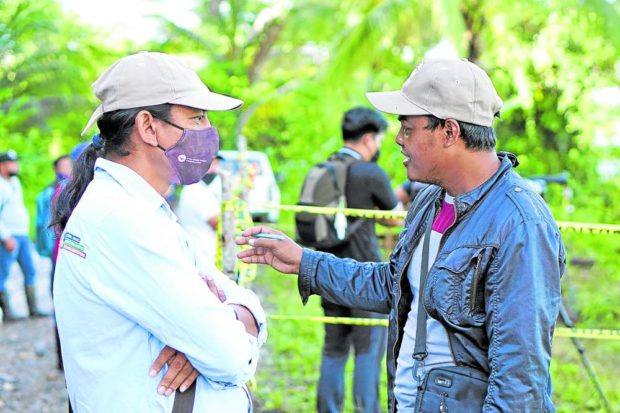Pandemic spawns threats vs PH eagle

FLY FREE In this photo, onlookers take snapshots as the Philippine eagle (Pithecophaga jefferyi) named “Rajah Cabungso-an” takes off on Nov. 17, more than seven months after its rehabilitation, to return to the forest where it was rescued in Lingig town, Surigao del Sur province. —PHOTOS BY ERWIN M. MASCARIÑAS
LINGIG, Surigao del Sur, Philippines — As “Rajah Cabungso-an,” a 5-year-old Philippine eagle (Pithecophaga jefferyi), walked out of his cage around 11 a.m. on Nov. 17, the few people who gathered in a plateau to witness a momentous event waited with bated breath for what would happen next.
Setting its sight on the forest a few kilometers away, the Philippine eagle then leapt forward and spread its wings. In an instant, the raptor was already hovering above, reunited with its natural habitat.
But the trip back to the wild took some eight months, and countless sacrifices by people who cared for the fate of the endangered national bird.
The eagle was named after the village in this town where he was rescued last March. He was caught in a trap intended for monitor lizards, locally called “bayawak,” also an endangered species.
Jerry Cotic, a councilman of Rajah Cabungso-an village, came across the bird in Sitio San Isidro while he, his son and fellow villager Richard Mahomoc were out to gather rattan. Believing it was a special bird because of its size, Cotic asked wildlife hunters to entrust the captured bird to him so he could turn it over to authorities.
Article continues after this advertisement“I didn’t know it was a Philippine eagle. I just felt that something was wrong with the way the unusually huge bird was being treated,” Cotic told the Inquirer in the vernacular.
Article continues after this advertisement
HEALTH CHECK Veterinarian Dr. Bayani Vandenbroeck conducts a final physical examination of Philippine eagle “Rajah Cabungso-an” before the bird of prey is released into its natural habitat. Vandenbroeck, in the photo below, cradles the rehabilitated eagle, which endured about six hours of travel from Davao City to Lingig, Surigao del Sur.
Ransom
But the hunters refused, offering it, instead, for P5,000 or it would end up a meal, recalled Cotic.
Not wanting to let the opportunity of saving the bird pass, Cotic and Mahomoc promised to come back with the money and pleaded to spare the animal’s life for a little more time.
While Cotic “guarded” the eagle, his son and Mahomoc went back to the village to raise money to ransom the bird. When they pooled enough, Cotic’s son, aboard a motorcycle, returned to Sitio San Isidro to bring the eagle to a safe place.
Mahomoc then volunteered to take it to Bislig City where his wife, Reynalyn Gay-od, works and maintains a boarding house. He asked her to contact personnel of the Department of Environment and Natural Resources (DENR) ahead as he travels there with the eagle.
Placing the bird inside a sack with its head out on a small opening, Mahomoc traveled for more than an hour on a motorcycle to Bislig. “It was a rough ride while I was hugging the bird as it tried to fight and even hurt me and the driver with its beak,” he said.
In Gay-od’s boarding house, they made a makeshift cage out of a dismantled table while waiting for the DENR to take custody of the raptor.
“When I saw the bird, I immediately fell in love with it. It was beautiful,” Gay-od said.
She recalled that she took pity of the bird as there where times when he let off a whimper. She decided to have the eagle stay in her room for the night.

RESCUER Richard Mahomoc (right), one of the people who rescued “Rajah Cabungso-an” from wildlife hunters, discusses with Dr. Jayson Ibañez, director for research and conservation at the Philippine Eagle Foundation, ways to protect the critically endangered national bird.
Alarmed
Personnel of the Philippine Eagle Foundation (PEF), the group running the Philippine Eagle Center at Malagos District in Davao City, arrived the following day (March 23) to take custody of the bird.
When rescued, the eagle weighed some 4 kilograms.What happened to Rajah Cabungso-an has alarmed conservationists at PEF.
Dr. Jayson Ibañez, PEF director for research and conservation, described the bird’s story as both painful and alarming.
Ibañez said the economic hardships brought by the pandemic had driven people in communities near the forests to rely on wildlife hunting and gathering in order to survive.
“We cannot blame them for trying to survive,” he said, noting that there should be measures undertaken to protect endangered wildlife while also addressing the subsistence needs of people.
Since the start of the pandemic in March 2020, PEF had recorded and attended to 10 rescued eagles in Mindanao. Of them, seven suffered from “human persecution” (four were trapped, one shot by an improvised shotgun and two hunted) and three weakened and caught by people then turned over to authorities.
The last rescue was in January this year in Kiamba town, Sarangani province. The raptor, wounded with a “marble bullet,” was trapped among the vines.
By human persecution, conservationists mean the activities that threaten the species, such as shooting and hunting, as well as deforestation.
Majority of those trapped or shot were juveniles whose sense of risk and danger are not well developed.
Ibañez said this was the largest number of rescued Philippine eagles in the country’s history.
“This should be considered an emergency for conservation,” he added.
Of the 10 birds, Rajah Cabungso-an was the fifth to be released back to the wild. But some rescued eagles will forever miss the wild like “Balikatan” who was also ransomed off in Gigaquit town, Surigao del Norte province, for P8,000. Ryan Orquina bought it from wildlife traders to free it from the cage.
He took care of the bird for three weeks until it was taken by PEF and brought to its conservation facility on Aug. 30 last year. It was later found that Balikatan’s left eye was already blind and a cataract is forming in the right, believed to be due to the long captivity.
Before Rajah Cabungso-an was released, he was fitted with a radio transmitter so conservationists could track his movements, and also draw a profile of his habitat to aid conservation efforts.